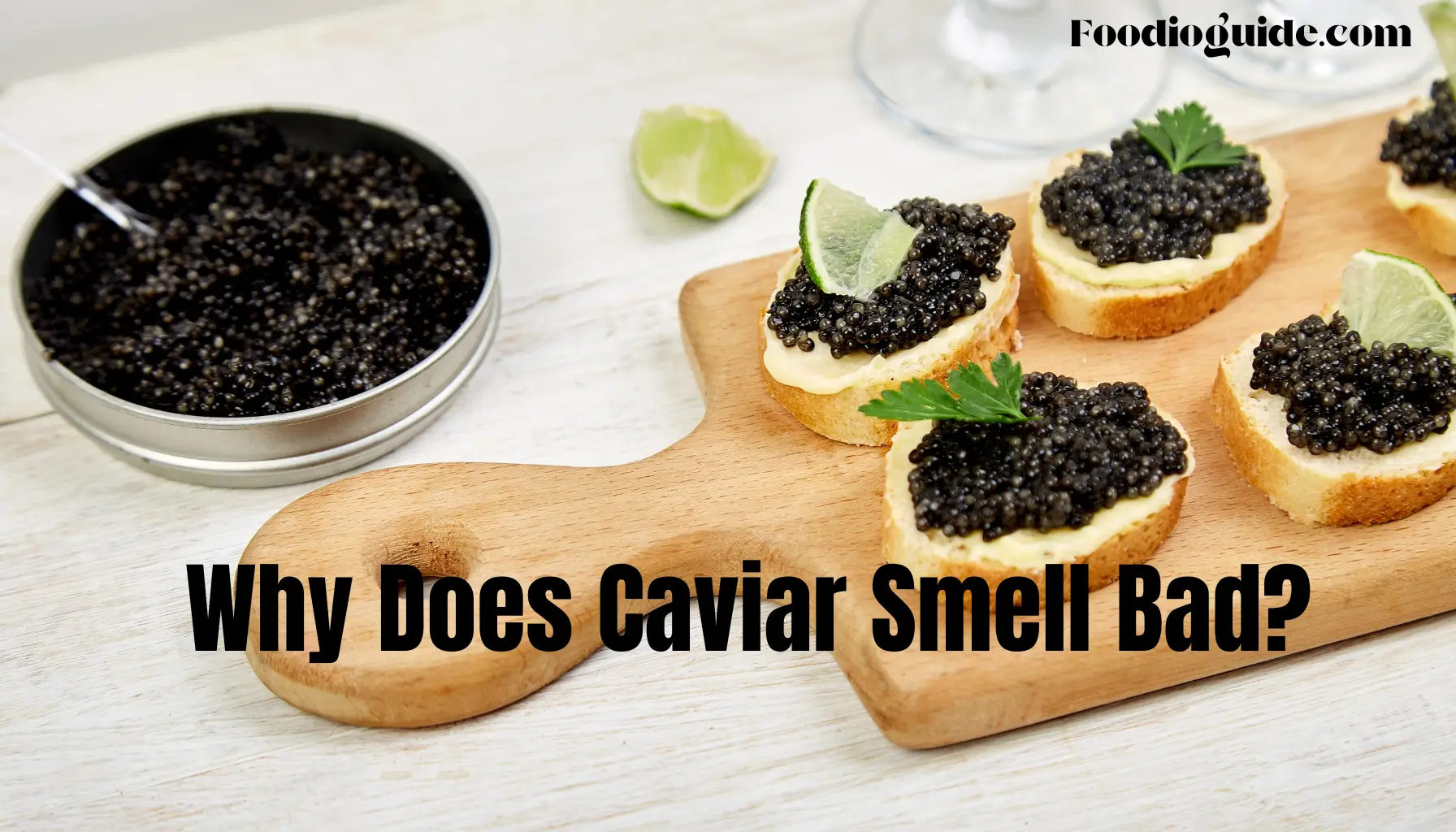Why Does Caviar Smell Bad?
Caviar, a delicacy known for its luxurious appeal, often comes with a distinctive smell that some find off-putting. For enthusiasts, it’s a symbol of sophistication, while others question its sensory appeal. But why does caviar smell bad to some people? Let’s dive into the origins of caviar’s scent and uncover the factors contributing to its unique aroma.
Understanding Caviar: A Luxurious Delicacy
Caviar is derived from the roe (eggs) of certain fish species, primarily sturgeon. These tiny pearls are praised for their rich flavor, smooth texture, and cultural significance in haute cuisine. However, the smell of caviar is a topic that sparks curiosity and sometimes skepticism.
The Composition of Caviar and Its Scent
Caviar’s smell is influenced by its composition. The eggs are rich in proteins, fats, and natural oils, which contribute to its unique aroma. Like many seafood products, caviar contains trimethylamine oxide (TMAO), which breaks down into trimethylamine (TMA) when exposed to air. TMA is the compound responsible for the “fishy” smell often associated with seafood.
The Role of Processing in the Aroma
The processing of caviar plays a significant role in its scent. High-quality caviar undergoes careful salting, known as “malossol,” which means “little salt.” This method preserves the natural flavors while minimizing the development of unpleasant odors. Conversely, poorly processed caviar or caviar stored improperly may develop a stronger, less appealing smell.
Factors Contributing to the Bad Smell of Caviar
Not all caviar smells bad, but several factors can contribute to an undesirable odor. These include freshness, storage conditions, and handling practices.
1. Freshness: The Key to Quality
Freshness is paramount when it comes to caviar. Fresh caviar typically has a mild, briny scent reminiscent of the sea. However, when caviar is not fresh, it can emit a pungent, fishy smell due to the breakdown of proteins and fats. Over time, the degradation process intensifies the odor, making it unpleasant.
Signs of Fresh Caviar
To determine the freshness of caviar, consider the following:
- Appearance: Fresh caviar should have shiny, uniform eggs.
- Texture: It should feel firm and not mushy.
- Smell: A clean, oceanic scent indicates freshness, while a strong, sour odor signals spoilage.
2. Storage Conditions: Temperature Matters
Improper storage is a leading cause of bad-smelling caviar. Caviar is highly perishable and requires refrigeration at temperatures between 28°F and 32°F (-2°C to 0°C). Any deviation from this range can accelerate bacterial growth, leading to spoilage and a foul smell.
Best Practices for Storing Caviar
- Store caviar in the coldest part of the refrigerator.
- Keep it in its original, airtight container to prevent air exposure.
- Consume opened caviar within 2-3 days to maintain freshness.
3. Handling Practices: Maintaining Quality
The way caviar is handled can also impact its aroma. Contamination from utensils or exposure to strong odors in the environment can alter its scent. Additionally, mishandling during transport or packaging can compromise its integrity.
Tips for Proper Handling
- Use non-metallic utensils, such as mother-of-pearl spoons, to avoid reacting with the eggs.
- Keep caviar away from pungent foods to prevent odor absorption.
- Always handle caviar gently to preserve its texture and flavor.
Does All Caviar Smell Bad?
It’s a widespread misconception that all caviar emits an unpleasant smell. In truth, premium caviar carries a refined and delicate aroma, characterized by a subtle oceanic essence rather than an overpowering fishy odor. This nuanced fragrance reflects its freshness and high-quality processing. However, perceptions of caviar’s smell can differ significantly due to cultural influences, individual sensory sensitivity, and prior experiences with seafood. For instance, while some might associate the aroma with luxury and sophistication, others may find it overwhelming if unfamiliar with such delicacies. Understanding these differences helps dispel myths about caviar’s scent, highlighting that its aroma is often a marker of quality rather than a flaw.
The Subjectivity of Smell Perception
Smell perception is highly subjective and varies from person to person. What one individual finds unpleasant, another may find appealing. Factors such as cultural background, personal taste, and familiarity with seafood can influence how caviar’s aroma is perceived.
Cultural Preferences
In cultures where seafood is a staple, the smell of caviar may be considered normal or even desirable. Conversely, individuals unaccustomed to seafood may find the scent overwhelming.
The Impact of Caviar’s Source on Smell
The type of fish, diet, and environment all contribute to the aroma of caviar. For instance:
- Beluga Caviar: Known for its mild and buttery aroma.
- Ossetra Caviar: Has a nutty, oceanic scent.
- Sevruga Caviar: Tends to have a stronger, more pronounced smell.
How to Mitigate the Smell of Caviar
If you find caviar’s smell unpleasant, there are ways to enjoy this delicacy without being overwhelmed by its aroma. Pairing caviar with complementary flavors like crème fraîche, blini, or chilled vodka can help neutralize its strong scent. Additionally, ensuring the caviar is fresh and sourced from reputable suppliers minimizes unpleasant odors. Proper storage, such as keeping it in airtight containers and at the right temperature, is crucial to preserving its delicate aroma. By following these steps, you can fully enjoy caviar’s luxurious taste without being distracted by its smell.
Pairing Caviar with Complementary Flavors
Pairing caviar with mild, creamy foods can help balance its aroma. Popular pairings include:
- Crème Fraîche: Adds a smooth, tangy contrast.
- Blini: Neutralizes the smell with a soft, doughy texture.
- Chilled Vodka or Champagne: Cleanses the palate and enhances the experience.
Ensuring Freshness and Quality
Investing in high-quality caviar from reputable sources ensures a better sensory experience. Always verify the expiration date and choose caviar stored in optimal conditions.
See also: What Does Bleach Taste Like?
The Science Behind Caviar’s Smell
To better understand caviar’s aroma, let’s examine the science behind it. Caviar’s smell primarily stems from the breakdown of trimethylamine oxide (TMAO) into trimethylamine (TMA), which produces the characteristic fishy odor. This reaction intensifies when caviar is exposed to air or improper storage conditions. Additionally, lipid oxidation in caviar contributes to rancid smells, especially if the product is not fresh. Factors such as the water quality in fish farming and the fish’s diet also influence the aroma. Cleaner environments and nutrient-rich diets result in caviar with a milder, more appealing scent. Understanding these chemical and environmental factors can help demystify caviar’s unique aroma, making it easier to appreciate its luxurious appeal.
Chemical Compounds Responsible for the Smell
The primary compounds influencing caviar’s smell include:
- Trimethylamine (TMA): Causes the fishy odor in seafood.
- Lipid Oxidation Products: Can develop in improperly stored caviar, leading to rancid smells.
How Environmental Factors Play a Role
Environmental factors such as water quality and diet of the fish significantly impact the smell of caviar. Cleaner water and a balanced diet result in a milder aroma.
Why High-Quality Caviar Smells Different
High-quality caviar is processed meticulously to ensure minimal unpleasant odors. The harvesting process involves carefully selecting fresh eggs, which are then lightly salted using the malossol method to retain their natural flavor and aroma. Strict packaging conditions maintain freshness, preventing the development of off-putting smells and preserving the luxurious appeal of this delicacy.
Characteristics of Premium Caviar
- Minimal fishy odor.
- Smooth, clean taste.
- Proper texture and appearance.
Choosing Reputable Brands
When selecting caviar, opt for brands with a history of excellence. They prioritize quality control, ensuring a superior product.
The Role of Salt Content in Caviar’s Smell
Salt content plays a pivotal role in preserving caviar and influencing its aroma. Excessive salt can intensify the fishy smell, overshadowing the delicate flavor of the roe. On the other hand, striking the right balance in salting, such as in the malossol method, enhances the flavor while maintaining a subtle, oceanic aroma. Proper salting not only preserves the quality of the eggs but also ensures that the natural essence of caviar remains intact, making it an essential factor for both taste and sensory appeal.
Malossol Caviar: A Balanced Choice
Malossol caviar uses minimal salt, preserving the natural qualities of the roe without overpowering its aroma.
Comparing Fresh and Pasteurized Caviar
Pasteurization influences both the smell and flavor of caviar. Fresh caviar, known for its delicate and oceanic aroma, is often preferred for its unaltered taste. However, the pasteurization process, which involves mild heat treatment to extend shelf life, can introduce subtle changes to the roe. This process may result in a slightly cooked or metallic scent, diminishing the fresh, natural aroma that connoisseurs value. Understanding these differences allows consumers to make informed choices based on their preferences and storage needs.
Benefits of Fresh Caviar
Fresh caviar is prized for its pure, oceanic aroma and superior taste.
How Water Quality Impacts Caviar
The environment in which fish are raised significantly impacts the quality and aroma of their roe. Clean, pollutant-free water is essential for producing caviar with a mild and pleasant smell, as contaminants or poor water conditions can lead to stronger, less desirable odors. Fish raised in pristine environments tend to yield roe that is not only better-tasting but also free from the overly fishy smell often associated with lower-quality caviar. Sustainable aquaculture practices, which prioritize water cleanliness and the health of fish, play a critical role in ensuring a superior product. By maintaining optimal water quality, producers can enhance the natural flavors and aroma of the roe, making it more appealing to consumers. This focus on the fish’s environment underscores the importance of sustainable practices in delivering high-quality, milder-smelling caviar that satisfies even the most discerning palates.
Sustainable Practices for Quality
Sustainable aquaculture practices ensure clean water and healthy fish, leading to higher-quality caviar.
Myths About Caviar’s Smell
Caviar’s distinct aroma often gives rise to misconceptions, many of which stem from unfamiliarity or exposure to inferior-quality products. Some believe all caviar inherently smells bad, but this is not the case with premium-grade varieties. High-quality caviar, when stored and processed correctly, carries a subtle oceanic scent rather than an overpowering fishy smell. These myths may also originate from poorly handled caviar or products past their prime, which can develop stronger, less desirable odors. Understanding the source, freshness, and proper storage methods helps dispel these misconceptions and allows for a fuller appreciation of caviar’s true aroma.
Busting the Myths
High-quality caviar doesn’t have a strong fishy smell, debunking the myth that all caviar is unpleasantly aromatic.
Popular Caviar Varieties and Their Smells
Different types of caviar have distinct aromas. Understanding these nuances can help you choose one that suits your preferences.
Exploring Aromas of Top Varieties
From the buttery scent of Beluga to the robust aroma of Sevruga, each variety offers a unique olfactory experience.
Conclusion: Understanding and Appreciating Caviar’s Aroma
Caviar’s aroma is a natural characteristic of this exquisite delicacy. While some may find the smell strong, understanding the factors contributing to its scent can enhance your appreciation for caviar. By prioritizing freshness, proper storage, and quality handling, you can enjoy caviar’s luxurious flavor without being deterred by its smell.
Whether you’re a seasoned connoisseur or a curious first-timer, exploring the nuances of caviar’s aroma adds depth to the experience. Embrace the complexity of this delicacy and savor its unique qualities with an informed perspective.






